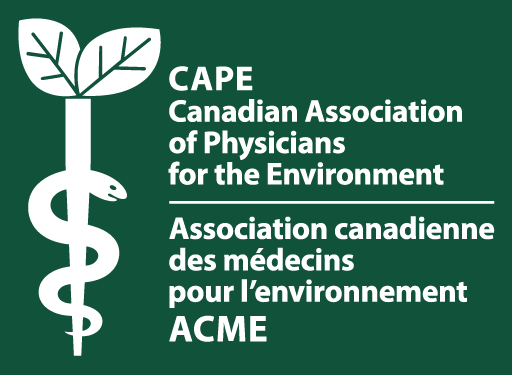Prepared by Kim Perrotta, MHSc, Executive Director, CAPE June 2017
On May 29th, the newly created Coalition for Action on Toxics held an event on Parliament Hill to draw attention to the changes needed to the Canadian Environmental Protection Act (CEPA) to ensure that it protects Canadians from highly toxic substances.
This new coalition—which is housed by Tides Canada, and includes EcoJustice, Environmental Defence, Équiterre, and CAPE—wants decision-makers to understand what changes are needed and how important they are.
“As a palliative care physician, I have spent too much of my career caring for people who are dying prematurely from diseases caused by toxic substances,” offered Dr. Jean Zigby, President of CAPE. “Our environmental regulations must be strengthened to prevent these avoidable deaths and diseases.”
These toxic exposures are costly to society in financial terms as well as human terms. One study published in The Lancet in 2016 estimated that toxic substances that disrupt the endocrine system alone cost the United States $340 billion per year in health care costs and lost wages (Attina et al., 2016). This figure represents 2.33% of the GDP!
CEPA, the backbone of environmental laws federally, has not been revised since 1999. The Standing Committee on Environment and Sustainable Development, which has been consulting the public on the revisions needed to CEPA since the fall of 2016, is expected to release its report in the coming weeks.
The coalition has identified a number of key priorities that must be addressed if human health and the environment are to be properly protected from toxics in the environment and in consumer products. We believe that CEPA should be revised to:
- Reverse the burden of proof for substances for highly toxic substances so that industry must prove that they are safe to use;
- Require assessment of alternatives and make it mandatory to substitute highly toxic substances with less hazardous substances;
- Increase protection for populations that are particularly vulnerable to toxic substances such as children;
- Require risk assessments that consider exposures from different sources and from different substances and products;
- Create national air quality standards that are health protective, legally binding, and enforceable;
- Strengthen timelines to ensure that risk management options are assessed and implemented in an expeditious manner;
- Improve enforcement and provide the funds needed to properly enforce;
- Extend the right to know to consumers with mandatory labelling of toxic substances;
- Ensure that the chemicals are re-assessed in response to new scientific evidence, regulatory action in other jurisdictions, or public concerns; and
- Improve the review and approval process for new substances to make it truly protective of human health and the environment and transparent.
This is a once-in-a-generation opportunity to prevent chronic diseases in Canada, reduce health care costs, and protect the environment. Click here and let your Member of Parliament (MP) know that this is an important issue to you.
Reference:
Attina, Teresa M et al. “Exposure to endocrine-disrupting chemicals in the USA: a population-based disease burden and cost analysis.” The Lancet Disease and Endocrinology. Vol. 4. No. 12. December 2016.
